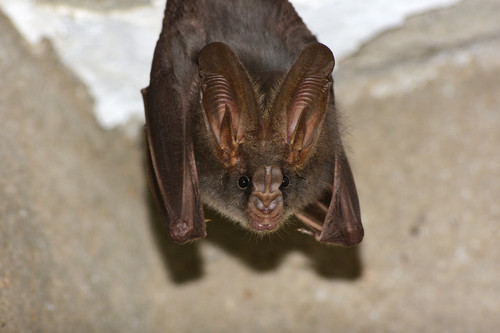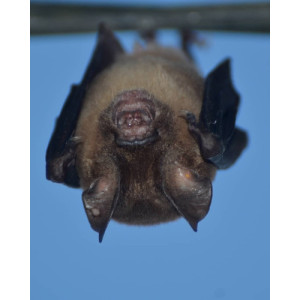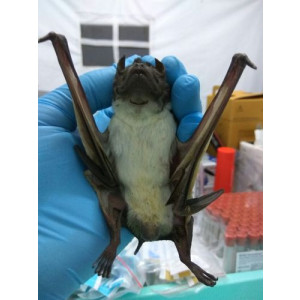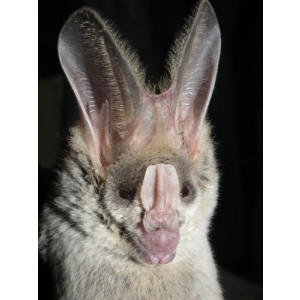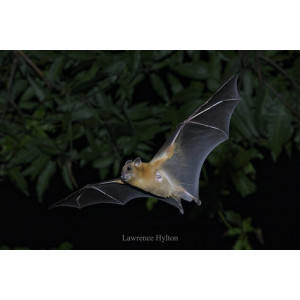Lesser False Vampire Did you see this animal?
Scientific Name : Megaderma spasma
Family : Megadermatidae
Order : Chiroptera
Class : Mammalia
Phylum : Chordata
Other Name : Common Asian Ghost Bat
Habitat : Forest, Rocky areas (eg. inland cliffs, mountain peaks), Caves and Subterranean Habitats (non-aquatic)
Description : The lesser false vampire bat is a medium-sized bat, with a wingspan of around 40-50 cm and a weight of up to 60 grams. It has large, rounded ears, and its fur is usually dark brown or black in color, with some individuals having lighter patches on their bellies.
This species of bat is found in a variety of habitats, including forests, grasslands, and agricultural areas. It is often associated with water sources, such as rivers and lakes.
The lesser false vampire bat is an insectivore, feeding primarily on moths and other flying insects. It hunts at night, using echolocation to locate its prey.
Like its larger relative, the greater false vampire bat, the lesser false vampire is known for its unusual behavior of using its wings to scoop up water from streams and lakes, which it then drinks while in flight. It also roosts in caves, hollow trees, and abandoned buildings in groups of up to 20 individuals.
Breeding occurs in the winter, with females giving birth to a single pup in the spring. The young are able to fly and hunt on their own after about two months.
The lesser false vampire bat is currently listed as "Least Concern" by the International Union for Conservation of Nature (IUCN), due to its wide distribution and apparently stable population. However, like many bat species, it faces threats from habitat loss and fragmentation, as well as from hunting and disturbance of roost sites. It is also sometimes captured for use in traditional medicine and may suffer from pesticide exposure through its insect prey. Conservation efforts are important to ensure the continued survival of this species and its important ecological role in controlling insect populations.
This species of bat is found in a variety of habitats, including forests, grasslands, and agricultural areas. It is often associated with water sources, such as rivers and lakes.
The lesser false vampire bat is an insectivore, feeding primarily on moths and other flying insects. It hunts at night, using echolocation to locate its prey.
Like its larger relative, the greater false vampire bat, the lesser false vampire is known for its unusual behavior of using its wings to scoop up water from streams and lakes, which it then drinks while in flight. It also roosts in caves, hollow trees, and abandoned buildings in groups of up to 20 individuals.
Breeding occurs in the winter, with females giving birth to a single pup in the spring. The young are able to fly and hunt on their own after about two months.
The lesser false vampire bat is currently listed as "Least Concern" by the International Union for Conservation of Nature (IUCN), due to its wide distribution and apparently stable population. However, like many bat species, it faces threats from habitat loss and fragmentation, as well as from hunting and disturbance of roost sites. It is also sometimes captured for use in traditional medicine and may suffer from pesticide exposure through its insect prey. Conservation efforts are important to ensure the continued survival of this species and its important ecological role in controlling insect populations.
Distribution in Bangladesh
References:
description written by:Asad U. Tanvir,Department of Zoology,Jagannath University,Dhaka; reviewed by:Muntasir Akash,Department of Zoology,University of Dhaka;Taxonomic Checklist:Red List of Bangladesh Volume 2: Mammals, 2015, IUCN; information sources:wikipedia,iucnredlist.org; photo credit:Piekfrosch(www.inaturalist.org/people/Piekfrosch), photo copyright: iNaturalist.more information please contact with us.
description written by:Asad U. Tanvir,Department of Zoology,Jagannath University,Dhaka; reviewed by:Muntasir Akash,Department of Zoology,University of Dhaka;Taxonomic Checklist:Red List of Bangladesh Volume 2: Mammals, 2015, IUCN; information sources:wikipedia,iucnredlist.org; photo credit:Piekfrosch(www.inaturalist.org/people/Piekfrosch), photo copyright: iNaturalist.more information please contact with us.
